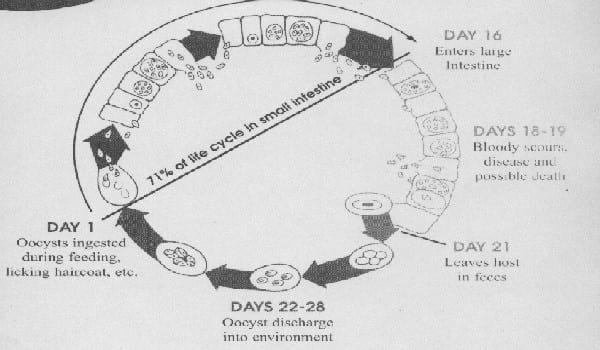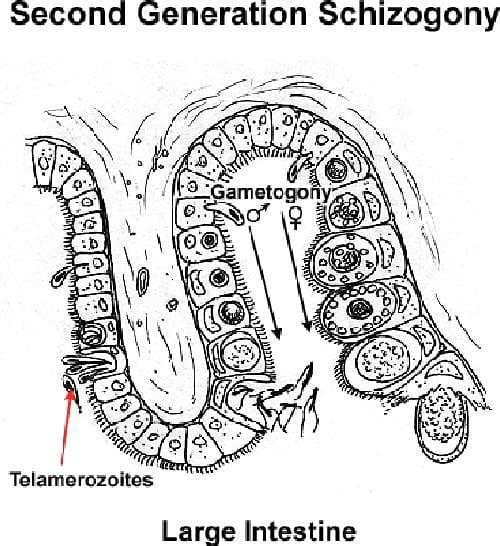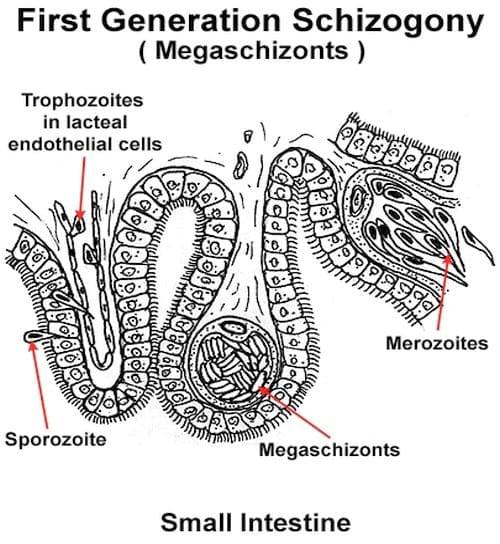Preventing Coccidiosis & Cryptosporidiosis In Beef & Dairy Cattle
Published: August 3, 2016
By: Courtesy of Growell India
Coccidiosis is a disease caused by a microscopic animal or protozoa and is characterized by diarrhoea, unthriftiness and variable levels of mortality. Tissue damage and changes in intestinal tract function may allow colonization by various harmful bacteria leading to various problems. Immunosuppressive diseases may act in concert with coccidiosis to produce more severe diseases.
Cryptosporidiosis is recognized worldwide, primarily in neonatal calves but also in lambs, kids, foals, and piglets. Cryptosporidia cause varying degrees of naturally occurring diarrhea in neonatal farm animals. The parasites commonly act in concert with other enteropathogens to produce intestinal injury and diarrhea.
At present, one has to look for total separate answers to the problems of Coccidiosis and Cryptosporidisosis, even though they belong to the same Protozoan family. That is why there is a need for a product that tackles both and does not allow tissue damage and changes in intestinal tract function without causing any negative side effects.
Coccidia are parasites that attack virtually all cattle. Feedlot cattle, stockers or dairy calves–all have a problem - called Coccidia. Their eggs, called oocysts, are everywhere there are cattle. Oocysts can remain dormant for long periods of time. Despite the best management, strictest sanitation measures or even extreme heat and cold, they’ll still be a threat. Once they enter the animal, they may reproduce and spread rapidly. They attack and permanently damage the lining of the small intestine, interfering with feed consumption, feed conversion and weight gains. When they reach the large intestine, the result can be bloody scours, secondary disease problems and even death due to coccidiosis.
Producers and veterinarians identify coccidiosis–the disease caused by Coccidia–as the third most serious health problem in beef and dairy calves. As this graphic shows, the Coccidia life cycle is continuous. Cattle are constantly being exposed to Coccidia and the health and production problems they cause.

Clinical (Symptomatic) Coccidiosis
The first sign of a clinical infection is scours.
Coccidia damage the intestinal lining. In clinical breaks, which affect only 5% of the infected animals, cattle often suffer from severe bloody scours. They lose water, electrolytes, blood and tissue. This can lead to dehydration, anemia and secondary disease or respiratory problems. Death is common. Even if they recover, one still ends up losing time and money as a result of treatment costs, lost performance and “poor-doers” that never catch up.
Everyday stress can trigger a clinical break.
Stress can easily trigger a clinical coccidiosis break. This includes common, everyday events such as:
- moving and shipping
- weather changes
- weaning
- co-mingling
- ration changes
- vaccination
- worming
- processing.

Subclinical (non-symptomatic) Coccidiosis
Healthy-looking calves can cost even more.
Almost 95% of infected calves never show obvious symptoms of clinical coccidiosis. This is the most important problem, as it never shows up and works as a silent killer. This silent infection robs calves of the ability to absorb nutrients and can go totally unrecognized. As Coccidia reproduce and multiply, they damage the intestinal lining. They interfere with feed consumption, feed conversion, weight gain and normal development.

Coccidia also suppress the immune system
In addition to limiting normal gains, growth and development, research shows that coccidiosis can suppress the immune system. As a result, subclinical coccidiosis may interfere with the system’s ability to effectively respond to infection, leaving animals much more susceptible to secondary diseases and respiratory problems.
Control & Prevention programs
Even with excellent management, one still needs an effective anticoccidial program to prevent losses due to coccidiosis. Prevention is defined as the ability to eliminate the development of clinical and subclinical signs of coccidiosis. Control is defined as the ability to limit the severity of clinical signs of coccidiosis. One can have a statistically significant level of control and still see clinical signs of coccidiosis.
What is being done now when Cattle have an outbreak
Treatment of coccidiosis with amprolium or any therapeutic product is a case of “too little, too late.” Once an animal shows clinical signs that require treatment:
- the damage is already done
- approximately 20% of calves treated may die
- animals that recover still end up being “poor-doers”, and
- they cost money in terms of treatment and lost performance
Limitations of existing Coccidiostats / Anticoccidials:
Used as a treatment for animals that already show symptoms of clinical coccidiosis, Amprolium is only effective against Coccidia that are at days 5 through 10 in the life cycle. However, since the Coccidia life cycle is continuous and Coccidia are present at all stages of the cycle at all times, Coccidia that are beyond day 10 will continue to develop, because damage to the small intestine, enter the large intestine & cause additional clinical symptoms. Similarly, it does not work on Coccidia before the age of day 5, which is more of sub-clinical coccidiosis. The area of activity for the ionophores, days 5 to 7, is even shorter. Coccidia that are present in stages beyond day 7 will also continue to develop, damaging the small intestine and entering the large intestine, where stress can easily trigger clinical coccidiosis.
Our Suggestion :
Coxynil is the first herbal-mineral Anticoccidial that answers to this problem. Coxynil is a combination of select herbs which works as coccidiocidal without causing any negative side effects e.g. weight gain problem or feed intake problem. At the same time, Coxynil is shown to develop immunity levels significantly upwards (Cell immunity, HI titres against New Castle disease, Cell mediated immune response (skin thickness), T Cell counts (ANAE) in various trials). Additionally, Coxynil does not allow the ingested Coccidia to penetrate the linings of the intestine & further, does not allow reproduction thus saving the tissue damage. Cattle during stress periods that are protected with Coxynil:
- eat sooner/eat more
- consume feed more uniformly
- reach full feed faster
- have better average daily gains
- gain more weight
- have better health/less mortality
Coxynil prevents Coccidia development and damage from day 1 through day 19– throughout the entire small intestine & large intestines – where almost all of the life cycle takes place. Ongoing intestinal damage is prevented, reducing losses from subclinical coccidiosis. Coxynil also prevents Coccidia from entering the large intestine where stress can easily trigger a clinical coccidiosis break, even acting against them in large intestines. Coxynil delivers the longest duration of activity available to effectively prevent coccidiosis. It is important to note that as Coccidia continue to reproduce and multiply outside the areas of activity of amprolium and the ionophores, they are damaging the intestinal lining. That damage interferes with the ability of the lining to absorb feed nutrients. That means the nutrients in the feed are being wasted. Coxynil :
- is extremely palatable
- does not reduce feed consumption
- encourages cattle to eat sooner and eat more
- delivers an extremely high level of anticoccidial activity
- has been proven safe
Dairy
Coxynil’s value in preventing & also treating coccidiosis (at double dosage) has been proven in various trials as well as with over 6 years of top results by many satisfied customers. Preventing coccidiosis with Coxynil pays off in improved performance for calves, stockers and feedlot cattle. Coxynil gives dairy calves a better start at reaching their full genetic potential. Coxynil, fed from birth through six months in milk replacers and starter and grower rations (@ 25 to 30 mg per kg of body weight per day), effectively prevents coccidiosis.
As a result, dairy calves:
- eat sooner/eat more
- gain better/develop faster
- stay healthier
Feedlot Stocker
Incoming cattle are under tremendous stress. Conditions are ideal for a coccidiosis break. Coxynil, fed for at least the first 4 weeks @ 40 mg per kg of body weight per day, effectively prevents coccidiosis, helping incoming cattle overcome initial stress. Coxynil prevents coccidiosis in stocker calves during periods of stress :
- improves overall performance
- increases daily gain
- reduces sick pulls/treatments
Important Note : In case of replacing an existing Anticoccidial half way with Coxynil, Coxynil should be given at double dosage for one week, followed by normal dosage. In case of an outbreak, double dosage should be administered for 7 days followed by normal dosage.
References:
Efficacy studies:
1. Coxynil’s in – vitro activity against coccidia oocysts (Nagpur Vet College - 2003)
2. Challenge studies in coccidiosis of Goats – Coxynil – a case study – February 2001
3. Challenge studies in coccidiosis of Sheep – Coxynil – a case study – March 2001Coxynil’s in – vitro activity against Clostridia perfringens (Bombay Vet College - 2003)
4. Natural Anticoccidial (Coxynil) for Broilers (with or without coccidiosis vaccine) – Federal University of Parana, Biological Sciences Sector, Dept. of Physiology, Brazil – 2003
5. Role of Coxynil in Pathology of coccidiosis in Poultry (challenge studies in Broilers & ND Titre studies in New Castle) – Nagpur Vet. College – 2000
6. Field trial report of Coxynil in Commercial Broilers in Mexico vis a vis Monesin & Nicarbazin– 2002
7. Challenge studies on Coxynil in mice coccidiosis – Germany – 2002
8. Trial of Herbolife (combination of Coxynil & Growell) at DPI, Brisbane, Australia in Broilers for coccidiosis control and growth promotion – 2002
9. Effect of Coxynil vs. Salinomycin in pathology of Coccidiosis in Broilers (Challenge & Control studies, Immunity parameters like T Cell & ND titres studies )– Bombay Vet. College, India – 2003
10. Field trial report of Coxynil in commercial broilers (cobb 500) in Italy vs. a vis. Maxiban-Monensin – 2003
11. Field trial report of Coxynil in commercial broilers (Coxynil vs. Salinomycin + Diclazuril) – India – 2003
12. Field trial report of Coxynil in Commercial broilers in E. Acervulina – Turkey - 2004
2. Challenge studies in coccidiosis of Goats – Coxynil – a case study – February 2001
3. Challenge studies in coccidiosis of Sheep – Coxynil – a case study – March 2001Coxynil’s in – vitro activity against Clostridia perfringens (Bombay Vet College - 2003)
4. Natural Anticoccidial (Coxynil) for Broilers (with or without coccidiosis vaccine) – Federal University of Parana, Biological Sciences Sector, Dept. of Physiology, Brazil – 2003
5. Role of Coxynil in Pathology of coccidiosis in Poultry (challenge studies in Broilers & ND Titre studies in New Castle) – Nagpur Vet. College – 2000
6. Field trial report of Coxynil in Commercial Broilers in Mexico vis a vis Monesin & Nicarbazin– 2002
7. Challenge studies on Coxynil in mice coccidiosis – Germany – 2002
8. Trial of Herbolife (combination of Coxynil & Growell) at DPI, Brisbane, Australia in Broilers for coccidiosis control and growth promotion – 2002
9. Effect of Coxynil vs. Salinomycin in pathology of Coccidiosis in Broilers (Challenge & Control studies, Immunity parameters like T Cell & ND titres studies )– Bombay Vet. College, India – 2003
10. Field trial report of Coxynil in commercial broilers (cobb 500) in Italy vs. a vis. Maxiban-Monensin – 2003
11. Field trial report of Coxynil in commercial broilers (Coxynil vs. Salinomycin + Diclazuril) – India – 2003
12. Field trial report of Coxynil in Commercial broilers in E. Acervulina – Turkey - 2004
Safety Studies:
1. Residues of Animal Drugs (Antibiotic analysis) & Plant protective residues (Pesticide residue analysis) – Poultry Diagnostic and Research Centre of Venkateshwara Hatcheries Ltd., Pune, India
2. LD 50 studies (Acute oral toxicity)
3. Mucous membrane test
4. Skin irritation test
5. Environment safety – Coxynil’s effect on Soil Microorganisms at normal and ten times dosage
2. LD 50 studies (Acute oral toxicity)
3. Mucous membrane test
4. Skin irritation test
5. Environment safety – Coxynil’s effect on Soil Microorganisms at normal and ten times dosage
Stability studies:
1. Thermal & Accelerated Stability (following OECD guidelines)
Bio-degradability Studies :
1. Bio-degradability studies (following OECD guidelines)
Chemical / Proximate studies:
1. Proximate analysis
2. Chemical analysis
2. Chemical analysis
Microbiological Studies:
1. E Coli
2. Salmonella
3. Clostridia
4. Coliforms
2. Salmonella
3. Clostridia
4. Coliforms
For more details, please write to :
Growell India
FAMI QS & ISO 9001:2008 Certified
‘Shivalik’, Plot No. 14, Gangadham
Market Yard, Pune 411037, India
Tel : +91 20 24240170; Fax : +91 20 24247181
FAMI QS & ISO 9001:2008 Certified
‘Shivalik’, Plot No. 14, Gangadham
Market Yard, Pune 411037, India
Tel : +91 20 24240170; Fax : +91 20 24247181
Related topics
Authors:
Join to be able to comment.
Once you join Engormix, you will be able to participate in all content and forums.
* Required information
Would you like to discuss another topic? Create a new post to engage with experts in the community.
Create a postGrowell Group
8 de septiembre de 2016
We have university trials and successful repeated field trials for cyrptosporidiosis in various countries. For specific query and research data, please send us an email and we will give you all required details.
7 de septiembre de 2016
I am not sure why you should suggest claims may exist for cryptosporidiosis when in fact none exist. Your efforts to improve credibility for anything you say about Coxynil fail on these grounds with respect to cryptosporidiosis. It is a completely different target for a control strategy, and products for coccidiosis invariably fail if transferred to cryptosporidiosis.
Please give me the references which substantiate specific claims relating to cryptosporidiosis in dairy or beef calves.






